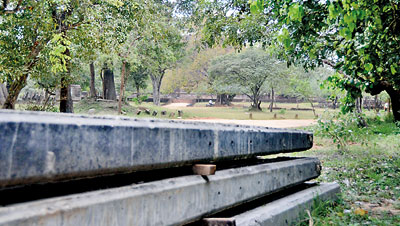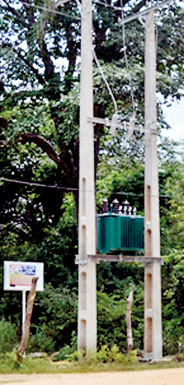News
World Heritage site in danger with power lines coming up in nature sanctuary
View(s):Posts would only be erected only on the perimeter, say officials
By Wasantha Ramanayake
The Archaeological Department (AD) and the Ceylon Electricity Board (CEB) are planning to put up large posts carrying electricity through the sanctuary and sacred city of Buddhist stupas and temples of the country’s medieval capital Polonnaruwa, which is on the UNESCO World Heritage List, despite much opposition to this venture.

Concrete posts for the power line brought into the sanctuary
The CEB and AD are planning to run a power line inside the Polonnaruwa Nature Sanctuary to light up the iconic Gal Vihara, Tivanka Image House and other archaological sites belonging to the medieval capital.
Large piles of posts to carry electricity have already been transported into the sanctuary close to the Pabalu Vehera and the ancient stupa of Rankoth Vehera, the fourth largest stupa in the country, a concerned resident of the area who wished to remain anonymous said.
The local community including vendors who sell various souvenirs to tourists, is protesting against the project. One of the vendors who wished to remain anonymous said that if the authorities erected those posts, the monuments would lose their glory and they would be an eyesore to the tourists who pay the exorbitant price of US$ 25 (around Rs. 3125) as entrance fee on which the Central Cultural Fund (CCF) is entirely dependent.
A percentage of the revenue also goes to the AD and the Treasury as well, they said. “If the tourists do not visit the place how is the CCF going to maintain the huge monuments,” they asked.
They also pointed out that all the archaeological sites already have electricity supply. More than two decades ago this underground electrification system was installed with foreign aid. There seems to be no justification for any additional electrification, they said.
“Why can’t the CEB repair the existing system, with a lesser amount of money,” they argued, adding that the debt-ridden CEB is draining money and passing its wasteful burdens on to the consumers.
They also accuse the CCF of failure to maintain the underground system although it earns millions of rupees from the entrance fees.
“The CCF security officers are only at the entrances to make sure the tourists have their tickets. They are not concerned with the safety of the monuments,” they charged.
They are also concerned that if those posts are erected to provide electricity to the monuments, it requires cutting down a large number of trees and clearing vegetation that for thousands of years have been the natural habitat critical to the support of wildlife in the sanctuary.

The transformer set up near Rankoth Vehera
“Rankoth Vehera might look like an Egyptian pyramid in the desert, if they fell those trees” one person remarked. Archaeology Commissioner General Dr. Senerath Dissanayake said the posts would be erected only along the perimeters of the sacred city and would not be erected within it.
“The underground system would provide the electricity to the monuments,” he said adding that the department has not still decided whether to erect lamp posts or set up the lights on the ground. He emphasized that no posts would be erected within the sacred city disturbing and visually polluting the view of the ancient monuments.
The CEB Polonnaruwa District Engineer however said the new electrification project was started as the existing system breaks down during rainy weather. When the area goes under water the system breaks down, he said. He also said the present system was beyond repair and would be replaced.
The new system is being installed under the supervision of the District Secretary, the Archaeological Department and the Ministry of National Heritage, he added.
He reiterated that no trees would be cut down or posts erected in the sacred city. “The CEB will only put up posts bordering the sacred city,” he added. Polonnaruwa District Secretary Nimal Abeysiri reiterated that posts would not be erected within the sacred city and the sanctuary.
He said that the project was not new but started as far back as 2010, on the directive of the President to protect the monuments from treasure hunters.
Follow @timesonlinelk
comments powered by Disqus














